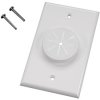Hello community, I read all the sticky notes in hopes of avoiding any duplicate questions, but I am a lay person when it comes to technology so I am coming here to you for help.
I am currently using a Linksys WRT45GS to get wireless throughout my home. However, I have a dead spot in a room about 75 feet away. I'm not sure if that's the correct terminology, but by dead spot I mean that the connection is spotty and intermittent at best.
Based on the research I've done so far, I can acknowledge that there are some environmental factors at play. There are several walls including wood, insulation and even possibly some marble that may be interfering with signal transmission.
I've dealt with the spotty connection for many years now but I feel like it's time to upgrade, if possible. I am able to run a hardwire connection from the router to the room, but isn't really a practical option for me at the present moment.
My main question for you is whether upgrading to the latest AC router would theoretically extend the Wi-Fi signal range enough so that I will have a stable connection in this dead spot. I don't have any AC capable devices but I want to emphasize that my main desire is for connection stability.
The main devices I'd like to operate in that room are a late 2012 iMac and an iPad air, if that information matters. I apologize if this is a common question but I couldn't really make sense of the router charts when based on range.
I am currently using a Linksys WRT45GS to get wireless throughout my home. However, I have a dead spot in a room about 75 feet away. I'm not sure if that's the correct terminology, but by dead spot I mean that the connection is spotty and intermittent at best.
Based on the research I've done so far, I can acknowledge that there are some environmental factors at play. There are several walls including wood, insulation and even possibly some marble that may be interfering with signal transmission.
I've dealt with the spotty connection for many years now but I feel like it's time to upgrade, if possible. I am able to run a hardwire connection from the router to the room, but isn't really a practical option for me at the present moment.
My main question for you is whether upgrading to the latest AC router would theoretically extend the Wi-Fi signal range enough so that I will have a stable connection in this dead spot. I don't have any AC capable devices but I want to emphasize that my main desire is for connection stability.
The main devices I'd like to operate in that room are a late 2012 iMac and an iPad air, if that information matters. I apologize if this is a common question but I couldn't really make sense of the router charts when based on range.



